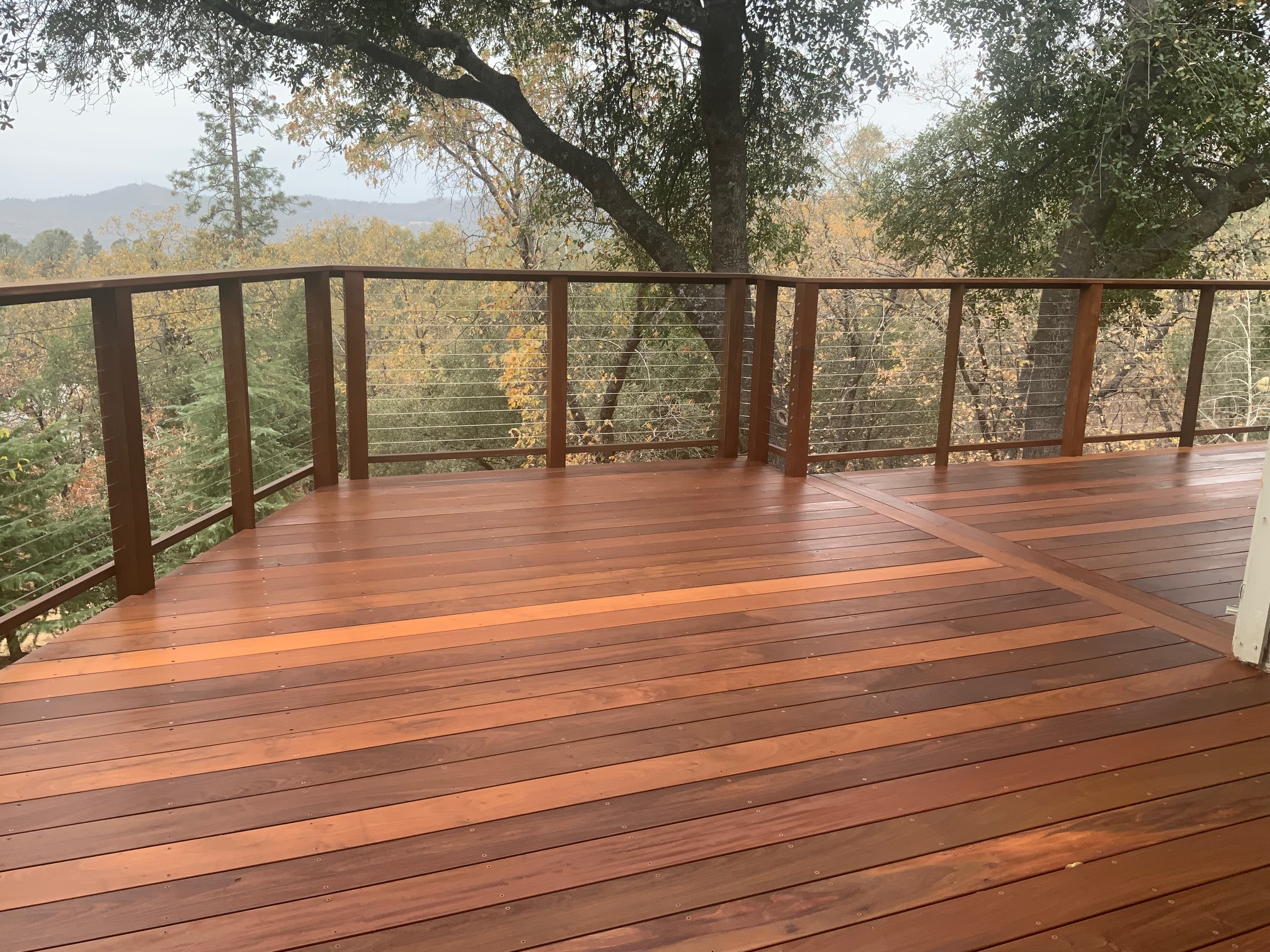To ensure optimal results, it is recommended to let your deck dry for at least 48 hours before staining. Proper drying time allows for better absorption and adhesion of the stain, resulting in a longer-lasting and more even finish.
A well-maintained deck enhances the beauty of outdoor spaces, providing ample room for relaxation and entertainment. However, to keep your deck looking its best, regular maintenance is crucial. One essential step in the maintenance process is staining the deck. Staining not only enhances the deck’s appearance but also protects it from the damaging effects of moisture and UV rays.
Before applying the stain, allowing the deck to dry thoroughly is necessary to ensure the best results. We will discuss the recommended timeframe for drying your deck and offer some tips for a successful staining process.

Credit: etpainting.com
Importance Of Drying
When it comes to staining your deck, one crucial step that should not be overlooked is allowing the deck to dry properly. The importance of drying cannot be emphasized enough as it plays a significant role in the success and longevity of your deck staining project. In this section, we will discuss the importance of drying and how it helps in avoiding moisture issues and preventing stain peeling.
Avoiding Moisture Issues
Maintaining dryness before staining is crucial to avoid moisture-related issues. Excess moisture trapped in the wood can lead to a multitude of problems, including mold and mildew growth, rotting, and structural damage. Allowing your deck to dry thoroughly before applying the stain is essential to ensure the wood is in its ideal condition for absorbing the protective coating effectively.
Moisture trapped in the wood can prevent proper adhesion of the stain, resulting in an uneven finish and limited durability. Additionally, moisture can cause the stain to peel off or bubble, compromising the appearance and protection of your deck. By giving your deck enough time to dry, you can help prevent these moisture-related issues and ensure a smooth and long-lasting stain application.
Preventing Stain Peeling
A common problem faced by homeowners is stain peeling shortly after application. This issue can be primarily attributed to insufficient drying time before staining. When the wood is not properly dried, the moisture trapped beneath the stain can cause it to peel or bubble, leaving an unsightly and unstable surface.
To prevent stain peeling, it is crucial to allow your deck to dry thoroughly. This involves accounting for factors such as weather conditions, wood type, and deck age. Generally, it is recommended to let the deck dry for at least 48 hours after cleaning and before staining. However, depending on these factors, the drying time may vary. By ensuring sufficient drying time, you can significantly reduce the risk of stain peeling and keep your deck looking beautiful and protected for years to come.
In conclusion, it is important to allow your deck to dry thoroughly before staining to avoid moisture issues and prevent stain peeling. By giving your deck enough time to dry, you can ensure a successful staining project with a beautiful and long-lasting finish.
Factors Affecting Drying Time
When considering how long to let a deck dry before staining, several factors can affect the drying time. These include humidity levels, temperature, and the type of wood. It is crucial to allow the deck to dry completely to ensure that the stain adheres properly and provides long-lasting protection.
When it comes to staining your deck, it’s crucial to let it dry properly beforehand. The drying time can vary depending on several factors. Understanding these factors is essential to determine the right amount of time to let your deck dry before staining.
Wood Type and Condition
The type and condition of the wood play a significant role in the drying time. Different wood species have varying moisture content and density, which directly affects the drying process. For instance, hardwoods like oak and mahogany take longer to dry compared to softwoods like pine.
Additionally, the condition of the wood also affects drying time. A new deck with freshly treated wood might require a longer drying period, as the moisture content is higher. On the other hand, older decks may have weathered wood, which tends to dry faster. Properly assessing the wood type and condition is crucial in determining the drying time for your deck.
Weather and Climate
The weather and climate conditions in your area can significantly impact the drying time of your deck. If you’re residing in a humid region, the moisture in the air can prolong the drying process. On the contrary, dry and arid climates tend to expedite the drying time.
Moreover, temperature also plays a vital role. Warmer temperatures facilitate faster evaporation and drying, while colder temperatures can slow down the process. It’s worth noting that outdoor temperature, as well as the temperature of the wood itself, should be considered to gauge the accurate drying time.
To summarize, two primary factors affect the drying time of your deck: the wood type and condition, as well as the weather and climate. By considering these factors, you can ensure that your deck is adequately dried before applying any stain, providing a beautiful and long-lasting finish.
Optimal Drying Time
Recommendations From Experts
When it comes to deck staining, allowing the wood to dry thoroughly is crucial in ensuring a successful and long-lasting finish. Deck drying time may vary based on factors such as weather conditions, wood type, and previous treatments. However, experts generally advise waiting at least 48 hours after power washing the deck to allow it to dry thoroughly. Keep in mind that this timeline can change based on the specific circumstances where the deck is located.
Testing Moisture Content
Testing the moisture content of the wood is essential before proceeding with staining. Ensure the wood’s moisture content is below 15% using a moisture meter. Excessive moisture levels can lead to poor stain absorption and adhesion, ultimately impacting the finish’s longevity. If the moisture levels are too high, allowing the deck to dry further is crucial before applying any stain.

Credit: www.readyseal.com
Drying Techniques
Properly drying your deck before staining is crucial to ensure the stain adheres well and lasts longer. This section will cover various techniques you can employ to dry your deck effectively.
Natural Drying Methods
If you prefer to let nature do its job, there are some effective natural drying methods you can utilize:
- Sunlight: The natural warmth and heat from the sun can help to evaporate the moisture on your deck surface. Ensure your deck receives ample sunlight by trimming nearby trees or vegetation that may cast shadows.
- Air Circulation: Maximizing air circulation is essential in drying your deck. Keep nearby windows and doors open to allow fresh air to circulate, promoting faster drying.
- Elevated Furniture: If you have patio furniture or other items on your deck, consider elevating them on blocks or using plastic spacers to allow air to flow freely underneath, aiding in quicker drying.
Assistance Of Drying Agents
If you’re looking to speed up the drying process, consider using drying agents. These can help absorb excess moisture and accelerate the drying time:
- Kitty Litter: Spread a layer of kitty litter across your deck and gently sweep it into the cracks. The absorbent properties of kitty litter help to draw out moisture from the wood.
- Desiccants: Utilize commercially available desiccant powders or granules. These drying agents are specifically designed to capture and remove moisture from surfaces.
- Dehumidifiers: If your deck is enclosed or located in a humid area, utilizing a dehumidifier can be beneficial. This device helps extract moisture from the air, aiding in faster drying.
Post-drying Preparation
Once your deck has thoroughly dried, you can begin the crucial step of prepping the surface before staining. This ensures a smooth and long-lasting result. Two important aspects of post-drying preparation include surface cleaning and sanding, as well as the application of conditioners. Let’s take a closer look at each of these steps:
Surface Cleaning
Before proceeding with any further steps, thoroughly cleaning the deck’s surface is essential. This not only removes dirt, grime, and other debris, but it also helps to open up the wood’s pores, allowing the stain to penetrate better and adhere properly. Here are some effective ways to clean your deck:
- Sweep the deck using a sturdy broom or brush to remove loose dirt and debris.
- Use a power washer to remove stubborn stains, mold, and mildew. Ensure you use a fan tip nozzle and keep the pressure at a safe level to avoid damaging the wood.
- If there are any grease or oil stains, use a deck cleaner or a mixture of warm water and dish soap to scrub them off.
- Rinse the deck thoroughly to remove any cleaning solution residue.
Sanding
Sanding the deck after cleaning helps smooth out rough spots, removes old stains or paint remnants, and creates a clean and even surface for the new stain to adhere to. Follow these steps to sand your deck effectively:
- Begin by using a floor sander with medium-grit sandpaper (around 60-80 grit) to remove any loose or flaking finish.
- Switch to a finer-grit sandpaper (around 100-120 grit) to smooth out the wood’s surface.
- In areas where the wood grain appears raised or rough, use a sanding block or sandpaper to even it out.
- After sanding, remove the dust by sweeping or using a leaf blower.
By thoroughly cleaning and sanding your deck, you are preparing it for the next step in the staining process. This ensures that the stain will not only enhance the natural beauty of the wood but also provide protection against the elements for years to come.

Credit: www.angi.com
Frequently Asked Questions On How Long To Let Deck Dry Before Staining
How Do I Know If My Deck Is Dry Enough To Stain?
To know if your deck is dry enough, conduct a simple water droplet test. Sprinkle water on the surface, and if it absorbs within a few moments, the deck is ready for staining. If it beads up, continue waiting for it to dry properly.
Avoid staining a damp deck as it can lead to poor results and ineffective protection.
Is 24 Hours Enough Time For A Deck To Dry Before Staining?
Yes, 24 hours is usually enough time for a deck to dry before staining.
How Long Should Deck Cure Before Staining?
Allow your deck to cure for at least 3 months before staining to ensure proper adhesion. This time frame allows the wood to acclimate and any chemicals to dissipate, resulting in a more effective and long-lasting stain application.
How Long After Rain Can I Stain My Deck?
Wait at least 48 hours after rain before staining your deck to ensure it’s completely dry.
Conclusion
Once your deck has thoroughly dried, you can begin the staining process to protect and enhance its appearance. Remember to follow the manufacturer’s instructions for best results. Properly drying your deck is crucial for a successful staining application. With patience and attention to detail, you can enjoy a beautifully stained deck for years to come.


